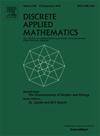A simplified graph parameter and its relationship to the modified Randić index
IF 1
3区 数学
Q3 MATHEMATICS, APPLIED
引用次数: 0
Abstract
Recently, Lin introduced a new graph parameter defined by nine properties and established the inequality , where is the harmonic index of . In this note, we simplify the framework by reducing the required properties to five, defining a new parameter . We prove , where is the modified Randić index, and characterize the equality case. It is known that . Then . Since needs fewer properties than , it has a high possibility that many known parameters satisfy the demands of .
一个简化的图参数及其与修改后的randiki指数的关系
最近,Lin引入了一个由九个性质定义的新的图参数ξ,并建立了不等式ξ(G)≤2H(G),其中H(G)是G的调和指数。在本文中,我们通过将所需的性质减少到五个来简化框架,定义了一个新的参数ζ。证明了ζ(G)≤2R ' (G),其中R ' (G)是修正的randiki指数,并刻画了等式的情形。已知R ' (G)≤H(G)≤R(G)。然后ζ(G)≤2 r (G)≤2 h (G)≤2 r (G)。因为ζ需要的性质比ξ少,所以很有可能有很多已知的参数满足ζ的要求。
本文章由计算机程序翻译,如有差异,请以英文原文为准。
求助全文
约1分钟内获得全文
求助全文
来源期刊

Discrete Applied Mathematics
数学-应用数学
CiteScore
2.30
自引率
9.10%
发文量
422
审稿时长
4.5 months
期刊介绍:
The aim of Discrete Applied Mathematics is to bring together research papers in different areas of algorithmic and applicable discrete mathematics as well as applications of combinatorial mathematics to informatics and various areas of science and technology. Contributions presented to the journal can be research papers, short notes, surveys, and possibly research problems. The "Communications" section will be devoted to the fastest possible publication of recent research results that are checked and recommended for publication by a member of the Editorial Board. The journal will also publish a limited number of book announcements as well as proceedings of conferences. These proceedings will be fully refereed and adhere to the normal standards of the journal.
Potential authors are advised to view the journal and the open calls-for-papers of special issues before submitting their manuscripts. Only high-quality, original work that is within the scope of the journal or the targeted special issue will be considered.
 求助内容:
求助内容: 应助结果提醒方式:
应助结果提醒方式:


